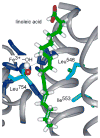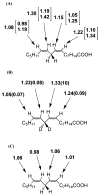Importance of protein dynamics during enzymatic C-H bond cleavage catalysis
- PMID: 23373460
- PMCID: PMC4091948
- DOI: 10.1021/bi301504m
Importance of protein dynamics during enzymatic C-H bond cleavage catalysis
Abstract
Quantum tunneling and protein dynamics have emerged as important components of enzyme function. This review focuses on soybean lipoxygenase-1, to illustrate how the properties of enzymatic C-H bond activation link protein motions to the fundamental bond making-breaking processes.
Conflict of interest statement
The authors declare no competing financial interest.
Figures









Similar articles
-
Active Site Dynamical Effects in the Hydrogen Transfer Rate-limiting Step in the Catalysis of Linoleic Acid by Soybean Lipoxygenase-1 (SLO-1): Primary and Secondary Isotope Contributions.J Phys Chem B. 2015 Jul 30;119(30):9532-46. doi: 10.1021/acs.jpcb.5b02385. Epub 2015 Jul 14. J Phys Chem B. 2015. PMID: 26079999
-
Catalytic efficiency of enzymes: a theoretical analysis.Biochemistry. 2013 Mar 26;52(12):2012-20. doi: 10.1021/bi301515j. Epub 2012 Dec 20. Biochemistry. 2013. PMID: 23240765 Free PMC article. Review.
-
Environmentally coupled hydrogen tunneling. Linking catalysis to dynamics.Eur J Biochem. 2002 Jul;269(13):3113-21. doi: 10.1046/j.1432-1033.2002.03022.x. Eur J Biochem. 2002. PMID: 12084051 Review.
-
Nature of hydrogen transfer in soybean lipoxygenase 1: separation of primary and secondary isotope effects.Biochemistry. 1999 Sep 21;38(38):12218-28. doi: 10.1021/bi990834y. Biochemistry. 1999. PMID: 10493789
-
Temperature-dependent isotope effects in soybean lipoxygenase-1: correlating hydrogen tunneling with protein dynamics.J Am Chem Soc. 2002 Apr 17;124(15):3865-74. doi: 10.1021/ja012205t. J Am Chem Soc. 2002. PMID: 11942823
Cited by
-
A Reactive Manganese(IV)-Hydroxide Complex: A Missing Intermediate in Hydrogen Atom Transfer by High-Valent Metal-Oxo Porphyrinoid Compounds.J Am Chem Soc. 2018 Mar 28;140(12):4380-4390. doi: 10.1021/jacs.8b00350. Epub 2018 Mar 15. J Am Chem Soc. 2018. PMID: 29542921 Free PMC article.
-
The Use of Multiscale Molecular Simulations in Understanding a Relationship between the Structure and Function of Biological Systems of the Brain: The Application to Monoamine Oxidase Enzymes.Front Neurosci. 2016 Jul 15;10:327. doi: 10.3389/fnins.2016.00327. eCollection 2016. Front Neurosci. 2016. PMID: 27471444 Free PMC article. Review.
-
Mimicking Elementary Reactions of Manganese Lipoxygenase Using Mn-hydroxo and Mn-alkylperoxo Complexes.Molecules. 2021 Nov 25;26(23):7151. doi: 10.3390/molecules26237151. Molecules. 2021. PMID: 34885729 Free PMC article.
-
Reflections on the catalytic power of a TIM-barrel.Bioorg Chem. 2014 Dec;57:206-212. doi: 10.1016/j.bioorg.2014.07.001. Epub 2014 Jul 11. Bioorg Chem. 2014. PMID: 25092608 Free PMC article.
-
Dynamical network of residue-residue contacts reveals coupled allosteric effects in recognition, catalysis, and mutation.Proc Natl Acad Sci U S A. 2016 Apr 26;113(17):4735-40. doi: 10.1073/pnas.1523573113. Epub 2016 Apr 11. Proc Natl Acad Sci U S A. 2016. PMID: 27071107 Free PMC article.
References
-
- Pauling L. Chemical achievements and hope for the future. Am Sci. 1948;36:51–58. - PubMed
-
- Hilvert D. Critical analysis of antibody catalysis. Annu Rev Biochem. 2000;69:751–793. - PubMed
-
- Rothlisberger D, Khersonsky O, Wollacott AM, Jiang L, DeChancie J, Betker J, Gallaher JL, Althoff EA, Zanghellini A, Dym O, Albeck S, Houk KN, Tawfik DS, Baker D. Kemp elimination catalysts by computational enzyme design. Nature. 2008;453:190–195. - PubMed
Publication types
MeSH terms
Substances
Grants and funding
LinkOut - more resources
Full Text Sources
Other Literature Sources

